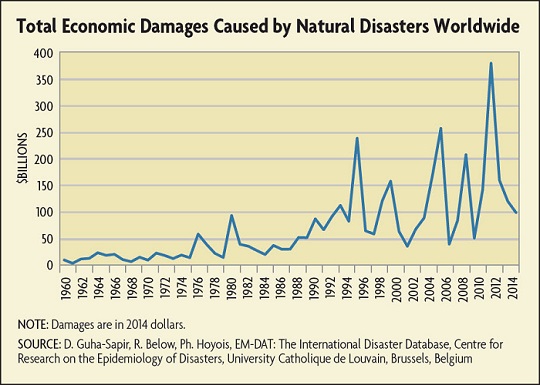

Dealing with Disasters
From hurricanes to asteroids, how should we determine what steps to take to avert catastrophe?

When Hurricane Hugo struck Charleston, S.C., in September 1989, it became the first natural disaster in the United States to cause more than $1 billion in insured losses. Today, after adjusting for inflation, it doesn’t even make the top 10 costliest U.S. disasters eight of which have occurred since 2000 alone. Indeed, disaster costs have been trending up worldwide over the last three decades (see chart below).
Asteroid Defense and Types of Public Goods
Like other types of disaster defense, protection against asteroids is a public good.
Disasters in general suffer from what economists call a "fat-tail" problem. In a normal statistical distribution, a classic bell curve, divergences from the mean in either direction are both increasingly rare and do not differ too drastically from the average. This is not true of fat-tail distributions. While extreme events are still rarer than the average, they can deviate from that average by much larger amounts, meaning that the next event could be orders of magnitude worse than the record holder up to that point. In extreme cases, there is essentially no limit to how bad the next disaster could be. Under such conditions, Weitzman says traditional cost-benefit analysis breaks down. It could be correct to spend any amount of resources on prevention if doing so means averting a true catastrophe.
That doesn’t necessarily provide a useful framework for making decisions, though. Weitzman allows that such large uncertainties may make it impossible to obtain agreement on an optimal solution before the risks become more apparent — at which point it may be too late to implement those solutions. With climate change, for example, cutting carbon emissions is not an effective plan to reduce global temperatures once they have already risen significantly. Given the reluctance to devote significant resources to avert theoretical future catastrophes, accepting suboptimal responses after the fact may be the best we can hope for, Weitzman has written.
"We tend to be unwilling to take strong steps to avert a crisis, but then after the crisis occurs we are more willing to do what we should have done all along," says Barrett. In the case of global threats, "you need to convince the whole world to do what it wouldn’t want to do normally. And that is unprecedented."
Readings
Barrett, Scott. "The Problem of Averting Global Catastrophe.![]() " Chicago Journal of International Law, January 2006, vol. 6, no. 2, pp. 527-552.
" Chicago Journal of International Law, January 2006, vol. 6, no. 2, pp. 527-552.
Barrett, Scott, and Astrid Dannenberg. "Negotiating to Avoid 'Gradual' versus 'Dangerous' Climate Change: An Experimental Test of Two Prisoners' Dilemmas.![]() " CESifo Working Paper No. 4573, January 2014.
" CESifo Working Paper No. 4573, January 2014.
"Catastrophes: U.S.![]() " Insurance Information Institute.
" Insurance Information Institute.
Giglio, Stefano, Matteo Maggiori, Johannes Stroebel, and Andreas Weber. "Discounting climate change investments.![]() " Vox EU, Jan. 23, 2016.
" Vox EU, Jan. 23, 2016.
Hallegatte, Stéphane. "How Economic Growth and Rational Decisions Can Make Disaster Losses Grow Faster Than Wealth.![]() " World Bank Policy Research Working Paper No. 5617, March 2011.
" World Bank Policy Research Working Paper No. 5617, March 2011.
Hallegatte, Stéphane, et al. Shock Waves: Managing the Impacts of Climate Change on Poverty.![]() Washington, D.C.: World Bank, 2016.
Washington, D.C.: World Bank, 2016.
Harrison, Glenn W., and Jack Hirshleifer. "An Experimental Evaluation of Weakest Link/Best Shot Models of Public Goods.![]() " Journal of Political Economy, February 1989, vol. 97, no. 1, pp. 201-225.
" Journal of Political Economy, February 1989, vol. 97, no. 1, pp. 201-225.
Healy, Andrew, and Neil Malhotra. "Myopic Voters and Natural Disaster Policy.![]() " American Political Science Review, August 2009, vol. 103, no. 3, pp. 387-406.
" American Political Science Review, August 2009, vol. 103, no. 3, pp. 387-406.
Kousky, Carolyn. "Informing Climate Adaptation: A Review of the Economic Costs of Natural Disasters." Energy Economics, November 2014, vol. 46, pp. 576-592. (Paper![]() available online with subscription.)
available online with subscription.)
Lempert, Robert L., et al. "Making Good Decisions Without Predictions: Robust Decision Making for Planning Under Deep Uncertainty.![]() " RAND Corporation Research Brief No. 9701, 2013.
" RAND Corporation Research Brief No. 9701, 2013.
Michel-Kerjan, Erwann O. "Catastrophe Economics: The National Flood Insurance Program.![]() " Journal of Economic Perspectives, Fall 2010, vol. 24, no. 4, pp. 165-186.
" Journal of Economic Perspectives, Fall 2010, vol. 24, no. 4, pp. 165-186.
"Mitigation's Value to Society." Federal Insurance and Mitigation Administration, 2012.
"The Neglected Dimension of Global Security: A Framework to Counter Infectious Diseases Crises.![]() " Commission on a Global Health Risk Framework for the Future, 2016.
" Commission on a Global Health Risk Framework for the Future, 2016.
Schade, Christian, Howard Kunreuther, and Philipp Koellinger. "Protecting Against Low-Probability Disasters: The Role of Worry.![]() " Journal of Behavioral Decision Making, December 2012, vol. 25, no. 5, pp. 534-543.
" Journal of Behavioral Decision Making, December 2012, vol. 25, no. 5, pp. 534-543.
Sommer, Geoffrey. Astronomical Odds: A Policy Framework for the Cosmic Impact Hazard.![]() Santa Monica, CA: RAND Corporation, 2005.
Santa Monica, CA: RAND Corporation, 2005.
Tol, Richard S. J. "The Economic Effects of Climate Change.![]() " Journal of Economic Perspectives, Spring 2009, vol. 23, no. 2, pp. 29-51.
" Journal of Economic Perspectives, Spring 2009, vol. 23, no. 2, pp. 29-51.
Receive an email notification when Econ Focus is posted online.
By submitting this form you agree to the Bank's Terms & Conditions and Privacy Notice.



